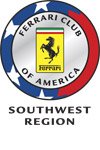
Physics of Racing - Part 7: The Traction Budget
By: Brian BeckmanThis month, we introduce the traction budget. This is a way of thinking about the traction available for car control under various conditions. It can help you make decisions about driving style, the right line around a course, and diagnosing handling problems. We introduce a diagramming technique for visualizing the traction budget and combine this with a well-known visualization tool, the "circle of traction," also known as the circle of friction. So this month's article is about tools, conceptual and visual, for thinking about some aspects of the physics of racing.
To introduce the traction budget, we first need to visualize a tire in contact with the ground. Figure 1 shows how the bottom surface of a tire might look if we could see that surface by looking down from above. In other words, this figure shows an imaginary "X-ray" view of the bottom surface of a tire. For the rest of the discussion, we will always imagine that we view the tire this way. From this point of view, "up" on the diagram corresponds to forward forces and motion of the tire and the car, "down" corresponds to backward forces and motion, "left" corresponds to leftward forces and motion, and "right" on the diagram corresponds to rightward forces and motion.
 Figure 1 - The Circle of Traction.
Figure 1 - The Circle of Traction.
The figure shows a shaded, elliptical region, where the tire presses against the ground. All the interaction between the tire and the ground takes place in this contact patch: that part of the tire that touches the ground. As the tire rolls, one bunch of tire molecules after another move into the contact patch. But the patch itself more-or-less keeps the same shape, size, and position relative to the axis of rotation of the tire and the car as a whole. We can use this fact to develop a simplified view of the interaction between tire and ground. This simplified view lets us quickly and easily do approximate calculations good within a few percent. (A full-blown, mathematical analysis requires tire coordinates that roll with the tire, ground coordinates fixed on the ground, car coordinates fixed to the car, and many complicated equations relating these coordinate systems; the last few percent of accuracy in a mathematical model of tire-ground interaction involves a great deal more complexity.)
You will recall that forces on the tire from the ground are required to make a car change either its speed of motion or its direction of motion. Thinking of the X-ray vision picture, forces pointing up are required to make the car accelerate, forces pointing down are required to make it brake, and forces pointing right and left are required to make the car turn. Consider forward acceleration, for a moment. The engine applies a torque to the axle. This torque becomes a force, pointing backwards (down, on the diagram), that the tire applies to the ground. By Newton's third law, the ground applies an equal and opposite force, therefore pointing forward (up), on the contact patch. This force is transmitted back to the car, accelerating it forward. It is easy to get confused with all this backward and forward action and reaction. Remember to think only about the forces on the tire and to ignore the forces on the ground, which point the opposite way.
You will also recall that a tire has a limited ability to stick to the ground. Apply a force that is too large, and the tire slides. The maximum force that a tire can take depends on the weight applied to the tire: F=uW where F is the force on the tire, u is the coefficient of adhesion (and depends on tire compound, ground characteristics, temperature, humidity, phase of the moon, etc.), and W is the weight or load on the tire.
By Newton's second law, the weight on the tire depends on the fraction of the car's
